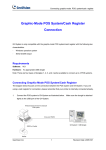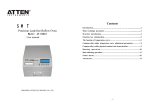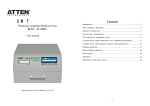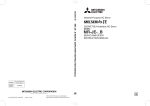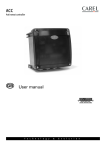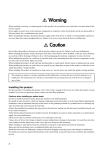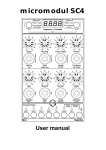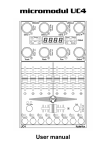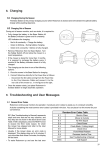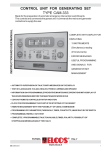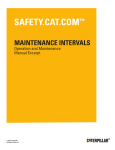Download SMT PRECISION LEADTFREE REFLOW OVEN
Transcript
electronics worldwide smt precision lead-free reflow oven USER MANUAL Associated publications Elektor SMT Precision Reflow Oven, Elektor October 2008. Before Baking…, Elektor October 2008. Baking…, Elektor October 2008. © Elektor International Media 2008 www.elektor.com www.elektor.de www.elektor.es www.elektor.nl www.elektor.fr Disclaimer Elektor International Media b.v. shall not be liable in contact, tort, or otherwise, for any loss or damage suffered by the purchaser(s) whatsoever or whosoever arising out of, or in connection with, the use of this equipment, other than, at the option of Elektor International Media, to refund the purchaser money in respect of the equipment if purchaser(s) returns equipment in unused, resalable condition, after having obtained written approval to do so from Elektor International Media b.v. Any use of the oven not explicitly described in this manual is strongly advised against and will void purchaser’s warranty. Equipment not suitable for heating foodstuffs, liquids or tissue. Equipment must not be used in the vicinity of children, animals or unqualified people. Contents Introduction . . . . . . . . . . . . . . . . . . . . . . . . . . . . . . . . . . . . . . . . . . . . 4 Main technical features . . . . . . . . . . . . . . . . . . . . . . . . . . . . . . . . . . . . . 4 Equipment description . . . . . . . . . . . . . . . . . . . . . . . . . . . . . . . . . . . . . 5 Control button descriptions . . . . . . . . . . . . . . . . . . . . . . . . . . . . . . . . . . 5 Function of the temperature curve . . . . . . . . . . . . . . . . . . . . . . . . . . . . . 6 Common alloy solder temperature curve adjustment parameters . . . . . . . . . 8 Common alloy solder physical constant and characteristics . . . . . . . . . . . . . 9 Operation . . . . . . . . . . . . . . . . . . . . . . . . . . . . . . . . . . . . . . . . . . . . . 10 The soldering process . . . . . . . . . . . . . . . . . . . . . . . . . . . . . . . . . . . . . 16 Fault alarms . . . . . . . . . . . . . . . . . . . . . . . . . . . . . . . . . . . . . . . . . . . . 17 Cautionary Notices . . . . . . . . . . . . . . . . . . . . . . . . . . . . . . . . . . . . . . . 18 Appendix A: parameters of factory-defined programmes . . . . . . . . . . . . . . 19 Appendix B: functional test at factory . . . . . . . . . . . . . . . . . . . . . . . . . . 20 Appendix C: tray temperature vs. displayed temperature . . . . . . . . . . . . . . 21 Appendix D: Ball Grid Array (BGA) soldering . . . . . . . . . . . . . . . . . . . . . . 22 Warranty statement . . . . . . . . . . . . . . . . . . . . . . . . . . . . . . . . . . . . . . 23 Introduction The Elektor SMT PRECISION LEADFREE REFLOW OVEN is an electrical appliance used for production and maintenance of circuit boards using SMT (surface mount technology) components. The equipment employs far-infrared heating elements as well as high quality temperature sensing devices and materials. By means of accurate control exercised by an internal microcontroller, temperature curves are obtained that closely match the requirements of circuit board production using SMT. The temperature control curve of the equipment can be adjusted accurately, allowing optimum use of a wide range of solder paste products with different material parameters. The oven can shut down and supply fault alarms automatically. Its functions cover PCB soldering and reworking as well as SMD drying. The performance and operation of the oven have been upgraded and improved from a previous version. Main technical features Line voltage: Line frequency: Max. power consumption: Heating methods: Menu languages: Readout: Modes of operation: 230 VAC 50-60 Hz 1650 W (10 A fused internally) infrared radiation and hot air mixed heating English or German (partly) LCD, Text mode or Graphics mode automatic reflow soldering; repair (maintenance); temp. adjustable Temperature phases (curve sections): Preheat, heat, solder, heat retention, cool down. Preheating temp. / time range: 70 ºC-150 ºC / 0-5 min. Heating temp. / time range: [preheating temp.] to 220 ºC / 0-5 min. Soldering temp. / time range: [heating temp.] to 280 ºC / 0-30 s (0-60 s below 260 ºC) Heat retention temp. / time range: [soldering temp.] to [soldering temp. – 0 to 50 ºC) Effective soldering area: 280×280 mm (11×11 inch) Size: 418×372×250 mm (16.5×14.6×10 inch) Weight: 16.7 kg (net) Case and finish: steel, high-gloss gray lacquer finish CE compliant RoHS compliant Equipment description Case Display Control buttons Power receptacle, fuse and power on/off switch (on rear panel) Drawer handle Drawer with SMT board tray Figure 1. Control button descriptions SOLDER PREH TEMP 150 ºC EXIT TIME 02 : 00 SET Figure 2. : press to turn the equipment on or off. It is not possible to switch the oven OFF if it is working or if the temperature has not dropped to a safe level. or : press to change parameter settings. : press to run set parameters and save settings. : press to run complete process, exit running process or exit setting process. Function of the temperature curve In the SMT production process the temperature curve should be adjusted according to different alloys of solder tin used, as well as the solder paste used, aiming to achieve the best quality of the finished product. Usually, reflow soldering comprises five temperature phases (curve segments). The temperature and the time of each phase can be set to satisfy the combined requirements of different circuit boards. The various temperatures and their role for the reflow phases are described individually. 1. Preheating phase Heating the PCB from room temperature to 120-150 ℃ serves to evaporate moisture, as well as to eliminate internal stresses and residual gasses of the PCB. By setting a period of 1 to 5 minutes for this segment, preheating is also a gradual transition to the next temperature phase, the optimum time depending on board size and the number of the components. 2. Heating phase Heating activates the liquid flux contained in tin alloy, enabling it to remove oxide layers from SMDs in preparation for soldering. For low-temperature lead alloy solder and precious metal alloy solder tin, the temperature in this phase should be set between 150 ºC and 180 ºC, for example, the Sn42%-Bi58% and Sn43%-Pb43%-Bi14% alloys. For midtemperature lead solder alloys, set the temperature between 180 ºC and 220 ºC. For high temperature lead-free solder alloys the temperature should be set between 220 ºC and 250 ºC. If you have reliable technical information on the solder material(s), the temperature of the heating phase can be set to about 10 ºC below the tin/solder melting point for best results. 3. Soldering phase This phase serves to finish the SMT soldering process. It has the highest temperature in the soldering process, hence components are easily damaged if the temperature and/or time are set incorrectly. The process is marked by substantial physical and chemical changes to the solder, which determine to a large extent the success of the entire soldering process. If you have reliable technical information on the solder material(s) in solid and liquid state, the soldering temperature can be set 30-50 °C above the melting point. Solder material may be divided into three groups: - low temperature (150-180 ºC); - mid-temperature (190-220 ºC); - high-temperature (230-260 ºC). Currently, lead-free solder materials for high-temperature soldering are the widest used. Low-temperature lead-free variants based on precious metals are also available for special requirements. At present, many lead-free solder materials are no substitute for lead solder as mid-temperature leaded solder has excellent properties in terms of electrical conductance, mechanical behaviour, hot and cold impact resistance, and the ability to act as an anti-oxidant. In this segment you can set the time according to several requirements discussed below. After high-temperature melting of the solder, all SMDs effectively float on the surface of the liquid solder. As a result of surface tension exerted by the flux and liquid, components will be pulled to the centre of solder pads, causing parts to be repositioned automatically. The solder flux vapour, solder tin and the metal surface of components together form an alloy layer that, by infiltration, yields structures ideal for soldering. A large PCB surface area and large component pads on the PCB generally govern a relatively long soldering time (10-30 s). However, this stage should be kept as short as possible to protect the components from damage due to overheating. 4. Heat retention phase This phase enables high-temperature liquid solder to solidify into firm joints. Solidification quality has a direct impact the crystal structure of the solder and mechanical properties. If the solidification process is too fast, rough crystalline will be formed causing a dull solder joint of reduced mechanical strength. Under high temperature and mechanical impact, such solder joints easily crack, eventually causing mechanical and/or electrical breakup and reduced product durability. At slowly declining temperatures, solder can solidify and crystallise properly. Generally set the temperature 10-20 ºC below the solder point. When the temperature has dropped to the set value, natural cooling takes over. 5. Cooling phase During this section of the temperature curve the temperature is reduced to a value that allows PCBs to be removed from the oven without the risk of scalding your hands. To speed up the cooling, you may also stop the process when the temperature drops below 150 ºC. To avoid burns, use tools (pliers, tweezers) or heat resistant gloves to take out the PCB board. 6. Note In general, start from low-temperature curves, aiming to satisfy the soldering requirements as much as possible to reduce the actual soldering temperature. Also note that longer heat retention times allow shorter soldering times to be used — this will help to protect lowtemperature components, especially some types of connector and plug, from melting or deforming. Components that do not fit the soldering temperature requirement should be handled separately after reflow soldering. Common alloy solder temperature curve adjustment parameters Preheat Heating Soldering ºC /30s Retain (‘Keep’) ºC ºC /min ºC /min Cool Sn43-Pb43-Bi14 100-120 130-150 200-210 170 150 Lead-free, low temperature Sn42-Bi58 100-120 120-130 180-200 150 150 Lead-free, low temperature Sn48-In52 100-120 120-130 180-200 150 150 Lead, mid- temperature Sn63-Pb37 130-150 170-180 230-240 180 150 Lead, mid- temperature Sn60-Pb40 130-150 170-180 230-240 180 150 Lead, mid- temperature Sn62-Pb46-Ag2 130-150 170-180 230-240 180 150 Lead-free, mid-temperature Sn96.5-Ag3.5 130-150 180-190 240-250 240 150 Lead-free, mid-temperature Sn87-Ag3-Cu3-In7 130-150 180-190 240-250 240 150 Lead-free, mid-temperature Sn91-Zn9 130-150 180-190 240-250 230 150 Lead-free, mid-temperature Sn95.4-Ag3. 1-Cn1.5 130-150 180-190 250-260 240 150 Lead-free, mid-temperature Sn99.3-Cu0.7 130-150 180-190 270-280 260 150 Lead-free, high temperature Sn94-Ag3-Cu3 130-150 190-220 240-250 240 150 Lead-free, high temperature Sn97-Cu3 130-150 190-220 270-280 250 150 Lead-free, high temperature Sn95-Sd5 130-150 190-220 270-280 250 150 Solder Type Composition Lead, low-temperature Melting temperature Solder Alloy Mechanical properties Conductivity Common alloy solder physical constants and characteristics Liquidus (ºC) Push Strength (MPa) Elongation (%) Rigidity (HB) 37 183 61 45 16.6 11.0 40 183 10 90 299 41 45 12.7 8.2 Sn Pb 63 60 Ag Sb Bi In Au Cu Zn 5 95 312 30 46 12.0 7.8 62 36 2 179 64 39 16.5 11.3 1 97.5 2.5 309 31 50 9.5 7.2 3.5 221 45 55 13 13.4 97.5 2.5 304 30 52 9.0 8.8 245 40 38 13.3 11.9 14 163 55 57 14 8.0 58 138 77 20-30 19.3 5.0 117 11 83 5 11.7 13.0 96.5 95 43 5 43 42 48 52 15 5 80 20 96.5 87 3 7 157 17 58 5 80 280 28 - 118 75 3.5 221 20 73 40 14.0 221 45 60 14 9.0 3 91 95.4 9 3.1 99.3 95 199 1.5 217 0.7 227 5 240 Operation There are two working modes to select on the equipment: Solder and Repair. The Solder mode is designed to solder components onto pads or tracks on the circuit board, the process comprising the phases displayed as PREH (preheating), HEAT (heating), SLDR (soldering), KEEP (heat retention) and COOL (wait for the machine to cool down). The Repair mode is designed to remove components from the circuit board. This phase has only one temperature section. Before you enter this mode, make sure the correct parameters are set. Parameters relevant to oven operation must be set on first time use or when the solder tin composition has been changed. 1. Power on Apply line power to the equipment by operating the rocker switch on the rear panel. The red light near the left corner top of the display will come on. To enter the standby state, press on the panel, as shown in Figure 3-1 or 3-2: SOLDER PREH TEMP 150 ºC RUN TIME 02 : 00 SET Figure 3-1. Oven standby page in Text-display mode. SOLDER PREH T:150ºC S: 00 : 30 1 300 200 Figure 3-2. Oven standby page in Graphic-display mode. 10 2. System settings To enter the system setting mode, turn on the line power switch, then press and hold down the button while pressing the button. As shown in Figure 4-1, the display shows the language and the LCD mode options. Press the or button to select your preference, then press to confirm it and finally press to save the setting. English √ German GraphMode TextMode √ OK Figure 4-1. System setting (Text mode). English √ German GraphMode TextMode 0 1 √ 4 5 2 3 OK Figure 4-2. System setting (Graphic mode). As shown in Figure 4-2, one of six curves can be selected. The curve designated ‘0’ is used for user-defined operation, allowing phase temperature and the time to be set. The parameters of the other curves 1 through 5 are fixed. You can find the parameters of each curve in the table in the Appendix. 3. Select work mode Under the standby screen, the display will be show the work state SOLDER or REPAIR. Press the button to select the work mode. As shown in Figure 3, press to enter the work state, or press to enter parameters settings. Press the button to exit the operating system. 11 4. Setting parameters In the standby menu press to enter the parameter setting menu. The mode column displays the current mode SOLDER. The curve section column displays the currently selected section. Press or to select the section you want to adjust. Pressing takes you back to the standby menu, while is used to enter the temperature setting state as shown in Figure 5. Note: Functionally, the operation using Graphics display mode is the same as with Text display mode. Only the readout is different. Preheating (PREH) parameter settings Press once to enter the Preheating settings menu, as shown in Figure 5. Press again to enter the temperature setting menu, as shown in Figure 6. Press or to change the temperature between 70 ºC and 150 ºC. Press the button to save, or press to discard changes. SOLDER PREH TEMP 150 ºC SOLDER PREH T:150ºC S: 00 : 30 TIME 02 : 00 300 200 EXIT SET Figure 5. Selecting the PREH(eat) menu (left: Text mode; right: Graphic mode). SOLDER PREH TEMP 150 ºC SOLDER PREH T:150ºC S: 00 : 30 TIME 02 : 00 300 200 EXIT OK Figure 6. Setting the preheat value (left: Text mode; right: Graphic mode). 12 1 After the temperature setting, press once to enter the time parameter setting state, as shown in Figure 7 (8). Press the or key to set the time between 0 and 5 minutes, then press to save the value. Next, press to enter the standby state. SOLDER PREH TEMP 150 ºC SOLDER PREH T:150ºC S: 00 : 30 TIME 02 : 00 300 200 EXIT OK Figure 7. Figure 8. In Graphic display mode, the curve will be redrawn automatically after returning to the standby state. Heating (HEAT) parameter setting As illustrated in Figure 9, press the key to select the heating phase. When the screen displays ‘HEAT’, press to enter the temperature setting. As shown in Figure 10, you press or to set the temperature to a value between [preheating temperature] and 220 ºC. SOLDER HEAT TEMP 200 ºC EXIT TIME 00 : 20 SOLDER HEAT OK TEMP 200 ºC EXIT Figure 9. TIME 00 : 20 OK Figure 10. Press the button to save the temperature setting and proceed to the time setting. As shown in Figure 11, press or to set a time between 0 and 5 minutes. Then press to save the setting and return to Mode Select, or press to enter the standby state, as shown in Figure 12. 13 SOLDER HEAT TEMP 200 ºC EXIT TIME 01 : 00 SOLDER PREH OK TEMP 150 ºC RUN Figure 11. TIME 02 : 00 SET Figure 12. Solder (SLDR) parameter setting In the menu shown in Figure 5, press to select the soldering phase, then press to enter the temperature setting menu. Press or to adjust the temperature to a value between [heating temperature] and 280 ºC. Next, press to save the setting and enter the time setting menu. For temperatures between 250 ºC and 280 ºC, a time span of 0 to 30 seconds is available. For temperatures lower than 250 ºC, a value between 0 and 60 seconds may be set. Next, press to save the setting or press to discard the modification. Retention (KEEP) parameter setting In the menu shown in Figure 5, press to select the temperature retention phase, then press SET to enter the temperature setting menu. Press or to change the setting value and then press to save it, or press to discard the modification. The software prohibits setting a value smaller than 50 ºC below that of the previous phase. Cooling (COOL) parameter setting In the menu shown in Figure 5, press to select the cooling phase, then press to enter the temperature setting menu. Press or to change the value from 70 ºC to that of the previous phase and then press to save it, or press to discard the modification. 14 Repair Mode parameter setting In the standby menu shown in Figure 13, first press to select Repair Mode, then to enter the temperature setting menu as shown in Figure 14. Press or to adjust the desired temperature, then press to save. Repair Mode offers three temperature ranges. For temperatures between 70 ºC and 150 ºC no time has to be set. For temperatures between 150 ºC and 200 ºC, the time range is 0 to 60 minutes. For temperatures between 200 ºC and 250 ºC the time range is 0 to 5 minutes. After the set time, the oven will shut down automatically. REPAIR HEAT TEMP 200 ºC EXIT TIME 10 : 00 REPAIR HEAT OK TEMP 200 ºC EXIT Figure 13. OK Figure 14. 15 TIME 10 : 00 The soldering process With all parameters set, the oven is ready to start the 5-phase reflow soldering process. Place the circuit board(s) in the centre of the tray, gently close the drawer and press to enter the working state, as shown in Figures 15-1 and 15-2. The ‘working’ indicator on the oven will light up and the screen will display: “Working…” with the temperature and time values being updated as the process evolves. When the temperature reaches the user-defined value, the time starts to count down. On completion of the count down, the machine will enter the next phase. When the machine finishes working the working lamp will flash or is turned off. Using Graphics display mode, the curve has a broken line as the time goes by, as shown in Figure 15-2. If you want to exit the ongoing process when the machine is running, press the button. may also be pressed to stop extractor fan activity (for gas and fume removal) and return to standby mode. SOLDER PREH TEMP 107 ºC SOLDER PREH T:150ºC S: 00 : 30 TIME 02 : 00 1 300 200 Working... EXIT Figure 15-1 (Text mode). Figure 15-2 (Graphic mode). During the cooling phase, the fan starts to assist with gas and fume removal. On completion of the cooling phase, the buzzer sounds and the status bar on the display shows “Complete”. Press to repeat the process. 16 Fault Alarms 1. Dangerous temperature Highest safe temperatures values apply to each phase while the oven is working. After you switch on the machine it will detect the current temperature. If the temperature exceeds the safe temperature by 10 ºC the display will show ‘Dangerous Temperature!’ (Figure 16) and blink. First the buzzer sounds and then the extractor fan starts to work. The alarm stops and the oven returns to normal operation when the temperature drops to the safe level. SOLDER ERROR: TEMP 172 ºC Dangerous Temperature! TIME 02 : 00 SOLDER ERROR: EXIT TEMP --- ºC Detecting Element! Figure 16. TIME 02 : 00 EXIT Figure 17. 2. Temperature detection failure When the temperature-detecting device in the oven develops a fault condition, the screen displays “Detecting Element!” as shown in Figure 17. The buzzer is activated and the fan starts to operate. You may press or to quit and return to the standby menu. 3. Heating element failure When the heating element in the oven develops a fault condition, the alarm will sound and the fan starts to work. The screen displays: ‘Heating Element Fault’ as shown in Figure 18. You may press or to quit and return to the standby menu. SOLDER ERROR: TEMP 35 ºC Heating Element Fault TIME 02 : 00 EXIT Figure 18. When an alarm condition arises, the oven will automatically enter the safe mode. If the fan does not come on or the heating element continues to operate, turn off the power immediately and check the fault. 17 Cautionary Notices 1. Do not connect other equipment on the same power outlet as used for the oven. Make sure the outlet and the power cord maintain a proper protective earth (PE) connection and are rated for at least 10 A (230 VAC version). 2. The Infrared Reflow Oven should be placed horizontally with at least 20 cms (8 inch) clearance to other equipment, objects or walls. 3. Do not use the oven in wet or high temperature environments. 4. Do not use water to clean the oven case. 5. Do not insert anything in the metal grille on the fan, or block the air intake or outlet. 6. Do not place or use combustible or explosive materials in or near the machine. Do not use the oven to dry materials or devices containing combustible gas(es). 7. To avoid damaging the internal infrared heat pipe, prevent objects from impacting the oven case. If a heat pipe malfunction is detected, turn off the power supply and request authorisation to return the unit for servicing. 8. Do not insert your hand(s) in the cabinet when the machine does not indicate that the inside has reached a safe temperature. In case of doubt, wear safety goggles and gloves. 9. To prevent blocking the air intake, do not use the machine when stood on a tablecloth. 10. If the infrared heat pipe is damaged, the replacement part must be authorised by the manufacturer to prevent damage and serious malfunctioning. 18 Appendix A Parameters of factory-defined programmes Prog. KEEP COOL temp. (ºC) PREH time (s) temp. (ºC) HEAT time (s) temp. (ºC) SLDR time (s) temp. (ºC) temp. (ºC) 1 120 60 160 58 190 30 170 150 2 130 60 180 58 200 30 185 150 3 140 60 200 58 220 30 210 150 4 150 60 220 58 250 30 240 150 5 150 60 220 58 280 30 265 150 Note: Prog. = programme - PREH = preheating - HEAT = heating - SLDR = soldering KEEP = retention - COOL = cooling down. Programme 0 = user-defined. 19 Appendix B Functional test at factory Your oven has been tested at the end of the manufacturer’s production line. It is certified to have successfully completed at least two complete reflow processes. The test was performed using these parameters: ✔ Pre-heating (PREH) ✔ Heating (HEAT) ✔ Soldering (SLDR) ✔ Temp. Retention (KEEP) ✔ Cool down (COOL) 300 PREHEATING 150 ºC for 60 seconds 220 ºC for 90 seconds 260 ºC for 30 seconds 245 ºC 150 ºC HEATING SOLDERING KEEPING COOLING DOWN TEMPERATURE [ºC] 250 200 150 100 50 0 0 30 60 90 120 150 TIME [SEC.] 20 180 210 240 270 300 Appendix C Tray temperature vs. displayed temperature The temperature value you may read on the display is the oven’s internal (air) temperature. This can be slightly different from the temperature measured on the PCB tray. The latter value is marginally lower in most cases. For this reason it is strongly suggested to run a few dummy tests before starting volume production of boards. The values given in Appendix A are good starting points allowing you to tune the various times for best results. 21 Appendix D Ball Grid Array (BGA) soldering Although the equipment is suitable for soldering BGA devices, this should be done with extreme caution, and only if sufficient expertise and experience has been developed by the user(s). The most difficult aspects of BGA soldering include 1. Component placement — this is extremely difficult by hand and really requires the use of specialized (expensive) optical equipment with camera and even x-ray support; 2. Reflow curve pre-testing — a time-consuming series of experiments may be required to arrive at a ‘known-good’ temperature curve for successful BGA soldering. Users should be aware that the soldering BGA devices is a complex task and might fail if he/she has little or no experience. It is recommended to 1. Refrain from using BGAs for any initial or beginners-level experiments with the oven. 2. Attend a hands-on seminar or workshop session on BGA soldering before trying the process on your own. The substance of the Disclaimer on the second page of this manual is reiterated here. 22 Warranty statement Definitions “The Company” shall refer to Elektor International Media B.V. “The Package” shall refer to the hardware, software and other component parts of this product. “The Period” shall be one year from the date of delivery. Warranty The Company warrants that this Package is free from significant defects in materials and workmanship for the Period. This warranty is not transferable, and does not include software upgrades. Checking your product This Package has been tested in the factory in accordance with the Company’s quality guidelines. We strongly recommend that you carry out your own tests with this product, in accordance with the User Test guidelines available for the product, which will confirm for you that this Package meets the specification for which it has been designed. Exclusions This Package, or parts of it, should not be used in life-critical applications. This warranty does not apply in the following cases: • Where the Package has been damaged as a result of using it in ways other than for which it is intended. Intended use is described strictly in the User Manual supplied with the Package • Where the Package has been modified. • As a result of service by a person not authorized by the Company. • Where damage occurs through improper transportation or packaging. • Where the Package is damaged through improper physical handling. • Where parts of this Package are lost or damaged. The Warranty does not apply to the consumable parts of this Package – e.g. ICs or components supplied with this Package including IC(s) contained in programmable systems which can be damaged by erroneous use. Disclaimer Except for the limited warranties made in this document, the Company disclaims all other warranties – expressed, implied or statutory – including, but not limited to, implied warranties of merchantability or fitness for a particular purpose. In no event shall the Company be liable for any incidental, special, or consequential damages, including, but not limited to, loss of business, profits, whether in action, contract or tort or based on a warranty, arising out of or in connection with the use or performance of this Package. The only warranty offered is the repair or replacement of the Package, or parts thereof at the Company’s discretion. The Company has the option to offer a refund, at its own discretion, under all circumstances. Obtaining warranty service Subject to the provisions above, you are entitled to service with respect to the Package with the following terms and conditions: Claims will only be honoured if made within the Period. • Before making a claim, please review the Package documentation – supplied electronically and/or on paper – and contact relevant representatives of The Company. • If you have problems, please contact the Company by telephone. Your assistance will be required in running any diagnostic tests the Company may feel suitable to ascertain where the problem with the Package lies. This will help in reducing the number of ‘no defect found’ problems. • Where a diagnostic test by telephone identifies one component at fault, the Company may send – by post or courier at the Company’s expense – a replacement part. • Where a diagnostic fault determines that an upgrade of software is required then the Company reserves the right to send this using email. • Where it is not possible to determine the fault and repair it remotely, the Package, or parts of it, will need to be returned to the Company. Please provide proof of purchase and serial numbers for any parts of the Package, as well as proof of shipment. • The company will seek to determine the fault with all returned Packages. • Where a returned Package is found to be defective in materials or workmanship, the Company will replace or repair the Package at its own expense. • Where no fault is found with a returned Package, the Company reserves the right to make a reasonable charge to compensate the Company for the time taken to service the Package. 23
























